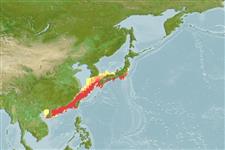Actinopterygii (ray-finned fishes) >
Perciformes (Perch-likes) >
Serranidae (Sea basses: groupers and fairy basslets) > Epinephelinae
Etymology: Epinephelus: Greek, epinephelos = cloudy (Ref. 45335). More on author: Bloch.
Environment / Climate / Range
Ecology
Marine; reef-associated; depth range 20 - 200 m (Ref. 5222). Tropical, preferred ?; 38°N - 18°N, 108°E - 142°E (Ref. 5222)
Northwest Pacific: Korea, Japan (north to Hegura-jima Island), China (south to Hong Kong and Hainan Island), and Taiwan.
Length at first maturity / Size / Weight / Age
Maturity: Lm ?, range 54 - ? cm
Max length : 136 cm TL male/unsexed; (Ref. 89707); common length : 60.0 cm TL male/unsexed; (Ref. 9137); max. published weight: 33.0 kg (Ref. 40637)
Dorsal
spines
(total): 11;
Dorsal
soft rays
(total): 13-15;
Anal
spines: 3;
Anal
soft rays: 8. Distinguished by the following characteristics: adults dark greyish brown; body covered with small pale grey spots forming short horizontal lines and mottled pattern; lower margin of the anal fin and lower corner of the caudal fin with white edge; juveniles pale yellowish brown, body with 6 irregular oblique dark bars containing irregular pale spots; elongate body, depth 3.0-3.6 times in SL; head length 2.3-2.5 in SL; convex interorbital area; angular preopercle, serrae at angle distinctly enlarged; inconspicuous dorsal spine on opercle; convex upper edge of operculum; small and subequal posterior and anterior nostrils; maxilla reaching past vertical at rear edge of eye, tiny embedded scales on maxilla; absence of step on ventral edge of maxilla; 2 rows of well-developed canines on midlateral part of lower jaw; caudal fin rounded; mid-lateral body scales ctenoid, without auxiliary scales on body (Ref. 089707).
Inhabits rocky reefs; also found on muddy grounds (Ref. 089707). Juveniles occur in shallow waters. Commercially cultured in Japan.
Life cycle and mating behavior
Maturity | Reproduction | Spawning | Eggs | Fecundity | Larvae
Heemstra, P.C. and J.E. Randall, 1993. FAO Species Catalogue. Vol. 16. Groupers of the world (family Serranidae, subfamily Epinephelinae). An annotated and illustrated catalogue of the grouper, rockcod, hind, coral grouper and lyretail species known to date. Rome: FAO. FAO Fish. Synop. 125(16):382 p. (Ref. 5222)
IUCN Red List Status (Ref. 115185)
CITES (Ref. 94142)
Not Evaluated
Threat to humans
Harmless
Human uses
Fisheries: commercial; aquaculture: commercial; gamefish: yes
More information
ReferencesAquacultureAquaculture profileStrainsGeneticsAllele frequenciesHeritabilityDiseasesProcessingMass conversion
Tools
Special reports
Download XML
Internet sources
